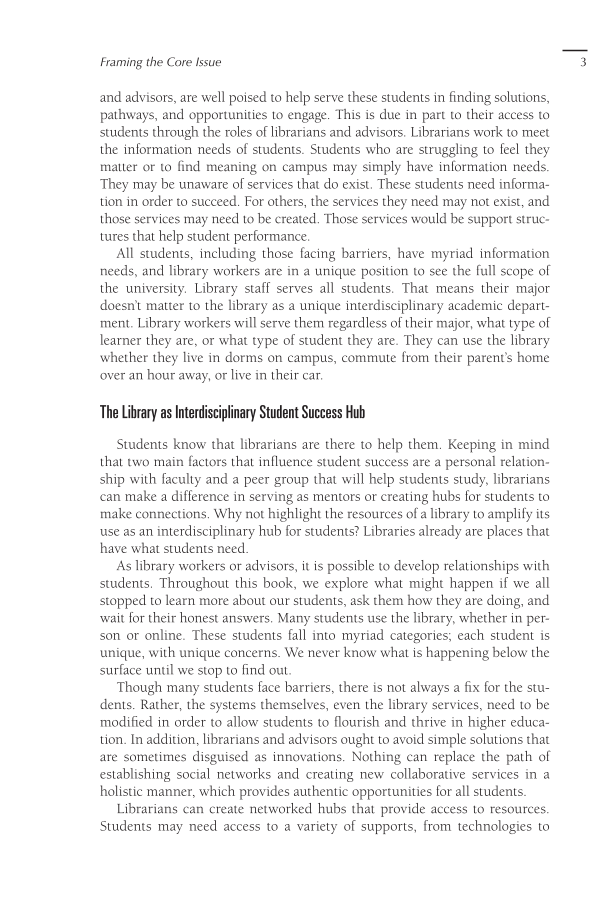Framing the Core Issue 3 and advisors, are well poised to help serve these students in finding solutions, pathways, and opportunities to engage. This is due in part to their access to students through the roles of librarians and advisors. Librarians work to meet the information needs of students. Students who are struggling to feel they matter or to find meaning on campus may simply have information needs. They may be unaware of services that do exist. These students need informa- tion in order to succeed. For others, the services they need may not exist, and those services may need to be created. Those services would be support struc- tures that help student performance. All students, including those facing barriers, have myriad information needs, and library workers are in a unique position to see the full scope of the university. Library staff serves all students. That means their major doesn’t matter to the library as a unique interdisciplinary academic depart- ment. Library workers will serve them regardless of their major, what type of learner they are, or what type of student they are. They can use the library whether they live in dorms on campus, commute from their parent’s home over an hour away, or live in their car. The Library as Interdisciplinary Student Success Hub Students know that librarians are there to help them. Keeping in mind that two main factors that influence student success are a personal relation- ship with faculty and a peer group that will help students study, librarians can make a difference in serving as mentors or creating hubs for students to make connections. Why not highlight the resources of a library to amplify its use as an interdisciplinary hub for students? Libraries already are places that have what students need. As library workers or advisors, it is possible to develop relationships with students. Throughout this book, we explore what might happen if we all stopped to learn more about our students, ask them how they are doing, and wait for their honest answers. Many students use the library, whether in per- son or online. These students fall into myriad categories each student is unique, with unique concerns. We never know what is happening below the surface until we stop to find out. Though many students face barriers, there is not always a fix for the stu- dents. Rather, the systems themselves, even the library services, need to be modified in order to allow students to flourish and thrive in higher educa- tion. In addition, librarians and advisors ought to avoid simple solutions that are sometimes disguised as innovations. Nothing can replace the path of establishing social networks and creating new collaborative services in a holistic manner, which provides authentic opportunities for all students. Librarians can create networked hubs that provide access to resources. Students may need access to a variety of supports, from technologies to
Document Details My Account Print multiple pages
Print
You have printed 0 times in the last 24 hours.
Your print count will reset on at .
You may print 0 more time(s) before then.
You may print a maximum of 0 pages at a time.


























































































































































